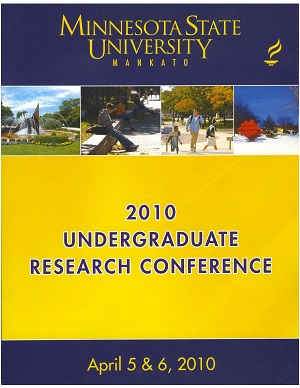Fluoroquinolone Antibiotic Complexes Involving Heavy Metals, Ciprofloxacin, and Phenolic Degradation Products: Potential Relevance in Groun and Waste Water Systems
Location
CSU 253/4/5
Start Date
5-4-2010 10:00 AM
End Date
5-4-2010 12:00 PM
Student's Major
Chemistry and Geology
Student's College
Science, Engineering and Technology
Mentor's Name
Trent Vorlicek
Mentor's Department
Chemistry and Geology
Mentor's College
Science, Engineering and Technology
Description
Pharmaceutical literature indicates that metal-fluoroquinolone complexes are highly stable and often have increased antimicrobial activity relative to the uncomplexed fluoroquinolone. However, minimal research has been conducted regarding the role metal-fluoroquinolones play in environmental systems. Our research aims to characterize novel metal-fluoroquinolones potentially relevant in ground and wastewaters.
Stoichiometric analyses of aqueous test solutions showed a highly insoluble 1:2:1 ternary complex formation between cadmium (Cd; a heavy metal found in animal wastes), ciprofloxacin (a common veterinary fluoroquinolone antibiotic) and 4-nitrophenol (an herbicidal degradation product) at dilute M concentrations and pH = 7. A 1:2:2 complex formed from similar solutions containing 2-chloro-4- nitrophenol. Furthermore, results pointed to the likely formation of an insoluble ternary complex between Cd, ciprofloxacin, and 2,6-dichloro-4-nitrophenol or 2-chloro-4,6-dinitrophenol. However, an insoluble complex did not form from similar solutions containing 2,4-dichlorophenol or 2,4,6-trichlorophenol.
Electrochemical experiments were performed to determine the presence of any soluble complexes between Cd, ciprofloxacin, and the phenolic compounds. Experiments at varying pH demonstrated that the base form of phenol is required for complex formation, implying phenolic compounds with pKa < 8 may be viable ligands at typical ground and wastewater pH. Stoichiometric, spectroscopic, and stability experiments involving other transition metals (Fe, Cu, Zn), ciprofloxacin, and chlorinated nitrophenols or chlorinated phenols are ongoing. These results potentially point to an unaddressed reaction pathway available to heavy metals, powerful antibiotics, and toxic phenolic degradation compounds.
Fluoroquinolone Antibiotic Complexes Involving Heavy Metals, Ciprofloxacin, and Phenolic Degradation Products: Potential Relevance in Groun and Waste Water Systems
CSU 253/4/5
Pharmaceutical literature indicates that metal-fluoroquinolone complexes are highly stable and often have increased antimicrobial activity relative to the uncomplexed fluoroquinolone. However, minimal research has been conducted regarding the role metal-fluoroquinolones play in environmental systems. Our research aims to characterize novel metal-fluoroquinolones potentially relevant in ground and wastewaters.
Stoichiometric analyses of aqueous test solutions showed a highly insoluble 1:2:1 ternary complex formation between cadmium (Cd; a heavy metal found in animal wastes), ciprofloxacin (a common veterinary fluoroquinolone antibiotic) and 4-nitrophenol (an herbicidal degradation product) at dilute M concentrations and pH = 7. A 1:2:2 complex formed from similar solutions containing 2-chloro-4- nitrophenol. Furthermore, results pointed to the likely formation of an insoluble ternary complex between Cd, ciprofloxacin, and 2,6-dichloro-4-nitrophenol or 2-chloro-4,6-dinitrophenol. However, an insoluble complex did not form from similar solutions containing 2,4-dichlorophenol or 2,4,6-trichlorophenol.
Electrochemical experiments were performed to determine the presence of any soluble complexes between Cd, ciprofloxacin, and the phenolic compounds. Experiments at varying pH demonstrated that the base form of phenol is required for complex formation, implying phenolic compounds with pKa < 8 may be viable ligands at typical ground and wastewater pH. Stoichiometric, spectroscopic, and stability experiments involving other transition metals (Fe, Cu, Zn), ciprofloxacin, and chlorinated nitrophenols or chlorinated phenols are ongoing. These results potentially point to an unaddressed reaction pathway available to heavy metals, powerful antibiotics, and toxic phenolic degradation compounds.
Recommended Citation
Weeramantri, Indumini A.; Trista L. Ayers; and Thomas G. Smith. "Fluoroquinolone Antibiotic Complexes Involving Heavy Metals, Ciprofloxacin, and Phenolic Degradation Products: Potential Relevance in Groun and Waste Water Systems." Undergraduate Research Symposium, Mankato, MN, April 5, 2010.
https://cornerstone.lib.mnsu.edu/urs/2010/poster-session-A/19



